How Well Can Persistent Contrails Be Predicted?
Abstract
:1. Introduction
2. Data and Methods
2.1. Data from Commercial Aircraft
2.2. Satellite Data
2.3. Reanalysis Data
2.4. EMAC Simulation Data
2.5. Methods
3. Results
3.1. Statistical Analysis
3.1.1. Conditions for Contrail Formation and Persistence
- Y/Y, hits: MOZAIC data show that a contrail is formed and the corresponding interpolated ERA-5 data have properties that would allow contrail formation as well.
- Y/N, miss: While the MOZAIC aircraft produces a contrail, ERA-5 data do not indicate that contrail formation is possible.
- N/Y, false alarm: While the MOZAIC aircraft does not produce a contrail, ERA-5 data indicate that contrails are possible.
- N/N, correct negatives: ERA-5 data indicate that contrail formation is impossible and indeed there was no contrail formed by the MOZAIC aircraft.
3.1.2. The Instantaneous Radiative Forcing
3.1.3. Comparison with EMAC Data
3.2. Case Studies
4. Discussion
4.1. Statistical Stability
- For the Schmidt-Appleman criterion we get an ETS range from to , the interquartile range is to , the mean value plus/minus one standard deviation is .
- For ice supersaturation we get an ETS range from to , the interquartile range is to , the mean value plus/minus one standard deviation is .
4.2. Spin-Up Effects
4.3. Alternative Vertical Interpolation Procedures
4.4. The Relative Humidity Field
5. Conclusions
Author Contributions
Funding
Acknowledgments
Conflicts of Interest
Appendix A. The Equitable Threat Score
References
- Lee, D.; Fahey, D.; Forster, P.; Newton, P.; Wit, R.; Lim, L.; Owen, B.; Sausen, R. Aviation and global climate change in the 21st century. Atmos. Environ. 2009, 43, 3520–3537. [Google Scholar] [CrossRef] [Green Version]
- Grewe, V.; Dahlmann, K.; Flink, J.; Frömming, C.; Ghosh, R.; Gierens, K.; Heller, R.; Hendricks, J.; Jöckel, P.; Kaufmann, S.; et al. Mitigating the Climate Impact from Aviation: Achievements and Results of the DLR WeCare Project. Aerospace 2017, 4, 34. [Google Scholar] [CrossRef]
- Lee, D.; Fahey, D.; Skowron, A.; Allen, M.; Burkhardt, U.; Chen, Q.; Doherty, S.; Freeman, S.; Forster, P.; Fuglestvedt, J.; et al. The contribution of global aviation to anthropogenic climate forcing for 2000 to 2018. Atmos. Environ. 2020. [Google Scholar] [CrossRef]
- Schumann, U. On conditions for contrail formation from aircraft exhausts. Meteorol. Z. 1996, 5, 4–23. [Google Scholar] [CrossRef]
- Gierens, K.; Spichtinger, P.; Schumann, U. Ice supersaturation. In Atmospheric Physics. Background—Methods—Trends; Schumann, U., Ed.; Springer: Heidelberg, Germany, 2012; Chapter 9; pp. 135–150. [Google Scholar]
- Marenco, A.; Thouret, V.; Nedelec, P.; Smit, H.; Helten, M.; Kley, D.; Karcher, F.; Simon, P.; Law, K.; Pyle, J.; et al. Measurement of ozone and water vapor by Airbus in-service aircraft: The MOZAIC airborne program, An overview. J. Geophys. Res. 1998, 103, 25631–25642. [Google Scholar] [CrossRef]
- Gierens, K.; Schumann, U.; Helten, M.; Smit, H.; Marenco, A. A distribution law for relative humidity in the upper troposphere and lower stratosphere derived from three years of MOZAIC measurements. Ann. Geophys. 1999, 17, 1218–1226. [Google Scholar] [CrossRef]
- Mannstein, H.; Spichtinger, P.; Gierens, K. A note on how to avoid contrails. Transp. Res. Part D 2005, 10, 421–426. [Google Scholar] [CrossRef]
- Neis, P. Water Vapour in the UTLS—Climatologies and Transport. Ph.D. Thesis, Johannes Gutenberg- Universität Mainz, Mainz, Germany, 2017. [Google Scholar]
- Petzold, A.; Neis, P.; Rütimann, M.; Rohs, S.; Berkes, F.; Smit, H.; Krämer, M.; Spelten, N.; Spichtinger, P.; Nedelec, P.; et al. Ice-supersaturated air masses in the northern mid-latitudes from regular in situ observations by passenger aircraft: Vertical distribution, seasonality and tropospheric fingerprint. Atmos. Chem. Phys. 2020, 20, 8157–8179. [Google Scholar] [CrossRef]
- Hoinka, K.; Reinhardt, M.; Metz, W. North Atlantic air traffic within the lower stratosphere: Cruising times and corresponding emissions. J. Geophys. Res. 1993, 98, 23113–23131. [Google Scholar] [CrossRef]
- Schumann, U.; Graf, K.; Mannstein, H. Potential to reduce climate impact of aviation by flight level changes. In Proceedings of the 3rd AIAA Atmospheric Space Environments Conference, Honolulu, HI, USA, 27–30 June 2011; p. 3376. [Google Scholar] [CrossRef] [Green Version]
- Schumann, U.; Heymsfield, A. On the lifecycle of individual contrails and contrail cirrus. Meteorol. Monogr. 2017, 58, 3.1. [Google Scholar] [CrossRef]
- Teoh, R.; Schumann, U.; Majumdar, A.; Stettler, M. Mitigating the climate forcing of aircraft contrails by small-scale diversions and technology adoption. Environ. Sci. Technol. 2020, 54, 2941–2950. [Google Scholar] [CrossRef] [PubMed]
- Royal Aeronautical Society, Greener by Design; Annual Report 2018–2019; Royal Aeronautical Society: London, UK, 2019.
- Hersbach, H.; Bell, B.; Berrisford, P.; Biavati, G.; Horányi, A.; Muñoz Sabater, J.; Nicolas, J.; Peubey, C.; Radu, R.; Rozum, I.; et al. ERA5 Hourly Data on Pressure Levels from 1979 to Present. Copernicus Climate Change Service (C3S) Climate Data Store (CDS). Available online: https://cds.climate.copernicus.eu/cdsapp#!/dataset/10.24381/cds.bd0915c6?tab=overview (accessed on 14 June 2018).
- Petzold, A.; Thouret, V.; Gerbig, C.; Zahn, A.; Brenninkmeijer, C.; Gallagher, M.; Hermann, M.; Pontaud, M.; Ziereis, H.; Boulanger, D.; et al. Global-scale atmosphere monitoring by in-service aircraft—Current achievements and future prospects of the European Research Infrastructure IAGOS. Tellus B 2015, 67. [Google Scholar] [CrossRef] [Green Version]
- Jöckel, P.; Tost, H.; Pozzer, A.; Kunze, M.; Kirner, O.; Brenninkmeijer, C.; Brinkop, S.; Cai, D.; Dyroff, C.; Eckstein, J.; et al. Earth System Chemistry integrated Modelling (ESCiMo) with the Modular Earth Submodel System (MESSy) version 2.51. Geosci. Model Dev. 2016, 9, 1153–1200. [Google Scholar] [CrossRef] [Green Version]
- Vázquez-Navarro, M.; Mannstein, H.; Mayer, B. An automatic contrail tracking algorithm. Atmos. Meas. Tech. 2010, 3, 1089–1101. [Google Scholar] [CrossRef] [Green Version]
- Kox, S.; Bugliaro, L.; Ostler, A. Retrieval of cirrus cloud optical thickness and top altitude from geostationary remote sensing. Atmos. Meas. Tech. 2014, 7, 3233–3246. [Google Scholar] [CrossRef] [Green Version]
- Vázquez-Navarro, M.; Mayer, B.; Mannstein, H. A fast method for the retrieval of integrated longwave and shortwave top-of-atmosphere upwelling irradiances from MSG/SEVIRI (RRUMS). Atmos. Meas. Tech. 2013, 6, 2627–2640. [Google Scholar] [CrossRef] [Green Version]
- Vázquez-Navarro, M.; Mannstein, H.; Kox, S. Contrail life cycle and properties from 1 year of MSG/SEVIRI rapid-scan images. Atmos. Chem. Phys. 2015, 15, 8739–8749. [Google Scholar] [CrossRef] [Green Version]
- Gierens, K.; Vázquez-Navarro, M. Statistical analysis of contrail lifetimes from a satellite perspective. Meteorol. Z. 2018, 27, 183–193. [Google Scholar] [CrossRef]
- Jöckel, P.; Kerkweg, A.; Pozzer, A.; Sander, R.; Tost, H.; Riede, H.; Baumgaertner, A.; Gromov, S.; Kern, B. Development cycle 2 of the Modular Earth Submodel System (MESSy2). Geosci. Model Dev. 2010, 3, 717–752. [Google Scholar] [CrossRef] [Green Version]
- Roeckner, E.; Brokopf, R.; Esch, M.; Giorgetta, M.; Hagemann, S.; Kornblueh, L.; Manzini, E.; Schlese, U.; Schulzweida, U. Sensitivity of simulated climate to horizontal and vertical resolution in the ECHAM5 atmosphere model. J. Clim. 2006, 19, 3771–3791. [Google Scholar] [CrossRef]
- Schumann, U.; Mayer, B.; Graf, K.; Mannstein, H. A parametric radiative forcing model for contrail cirrus. J. Appl. Meteorol. Climatol. 2012, 51, 1391–1406. [Google Scholar] [CrossRef] [Green Version]
- Ebert, E.; Curry, J. A parameterization of ice cloud optical properties for climate models. J. Geophys. Res. 1992, 97, 3831–3836. [Google Scholar] [CrossRef]
- Hoor, P.; Gurk, C.; Brunner, D.; Hegglin, M.; Wernli, H.; Fischer, H. Seasonality and extent of extratropical TST derived from in-situ CO measurements during SPURT. Atmos. Chem. Phys. 2004, 4, 1427–1442. [Google Scholar] [CrossRef] [Green Version]
- Tompkins, A.; Gierens, K.; Rädel, G. Ice supersaturation in the ECMWF Integrated Forecast System. Q. J. R. Meteorol. Soc. 2007, 133, 53–63. [Google Scholar] [CrossRef] [Green Version]
- Lamquin, N.; Gierens, K.; Stubenrauch, C.; Chatterjee, R. Evaluation of Upper Tropospheric Humidity forecasts from ECMWF using AIRS and CALIPSO data. Atmos. Chem. Phys. 2009, 9, 1779–1793. [Google Scholar]
- Dyroff, C.; Zahn, A.; Christner, E.; Forbes, R.; Tompkins, A.; van Velthoven, P. Comparison of ECMWF analysis and forecast humidity data with CARIBIC upper troposphere and lower stratosphere observations. Q. J. R. Meteorol. Soc. 2015, 141, 833–844. [Google Scholar] [CrossRef]
- Brenninkmeijer, C.; Crutzen, P.; Boumard, F.; Dauer, T.; Dix, B.; Ebinghaus, R.; Filippi, D.; Fischer, H.; Franke, H.; Frieß, U.; et al. Civil aircraft for the regular investigation of the atmosphere based on an instrumented container: The new CARIBIC system. Atmos. Chem. Phys. 2007, 7, 4953–4976. [Google Scholar] [CrossRef] [Green Version]
- Reichler, T.; Dameris, M.; Sausen, R. Determining the tropopause height from gridded data. Geophys. Res. Lett. 2003, 30, 2042. [Google Scholar] [CrossRef] [Green Version]
- Rosenow, J.; Fricke, H. Individual condensation trails in aircraft trajectory optimization. Sustainability 2019, 11, 6082. [Google Scholar] [CrossRef] [Green Version]
- Avila, D.; Sherry, L.; Thompson, T. Reducing global warming by airline contrail avoidance: A case study of annual benefits for the contiguous United States. Transp. Res. Interdiscip. Perspect. 2019, 2, 100033. [Google Scholar] [CrossRef]
- Kästner, M.; Torricella, F.; Davolio, S. Intercomparison of satellite-based and model-based rainfall analyses. Meteorol. Appl. 2006, 13, 213–223. [Google Scholar] [CrossRef] [Green Version]


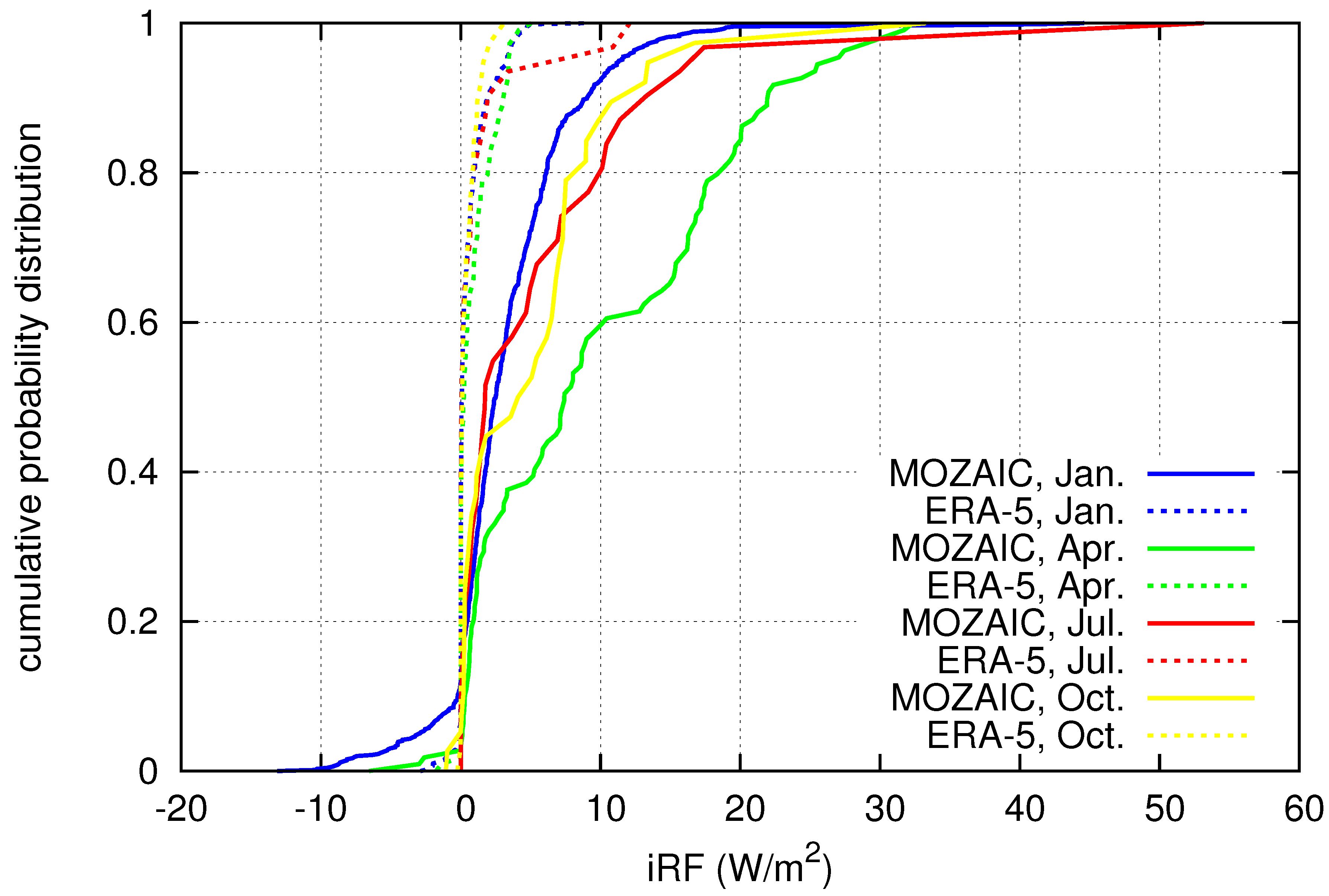

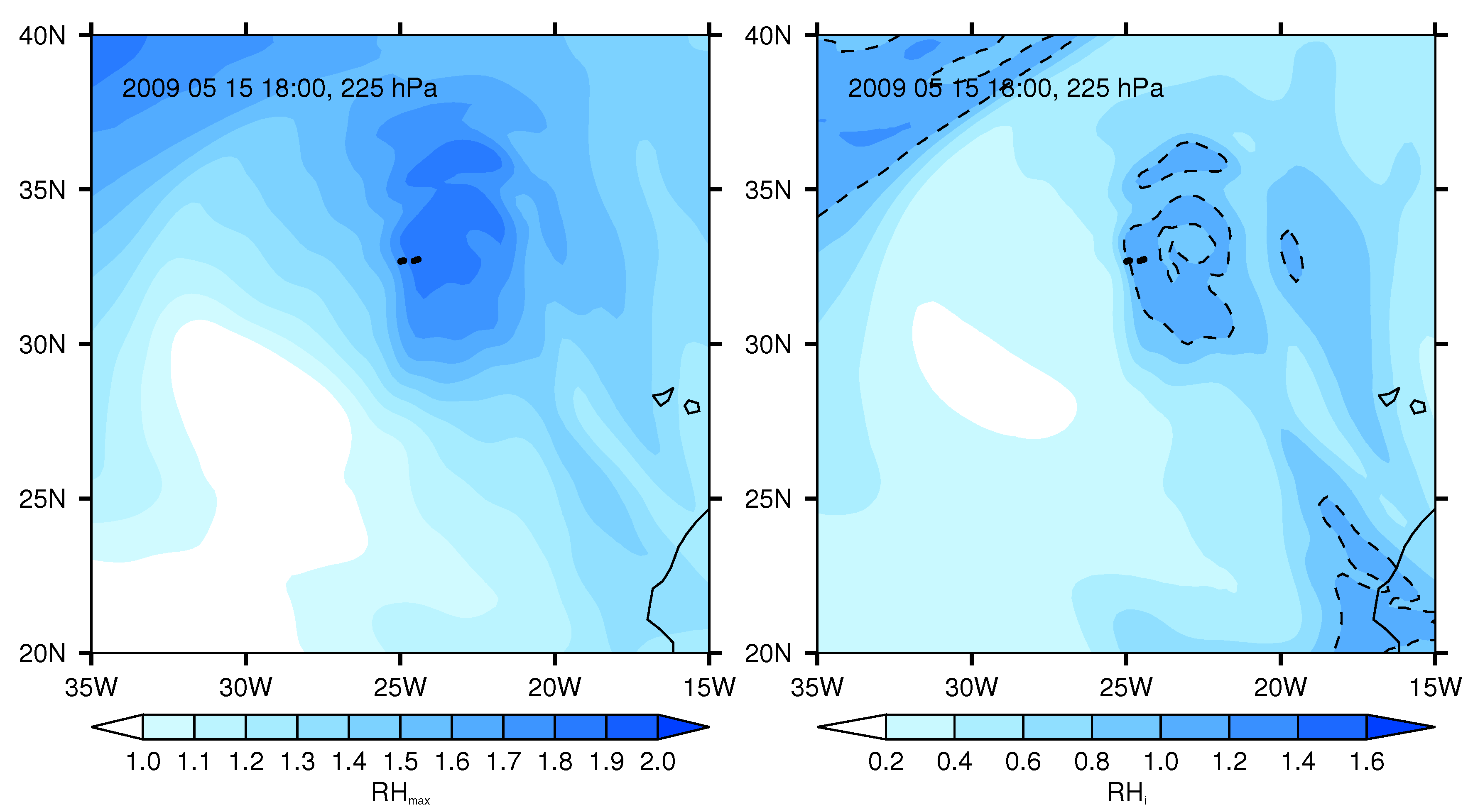
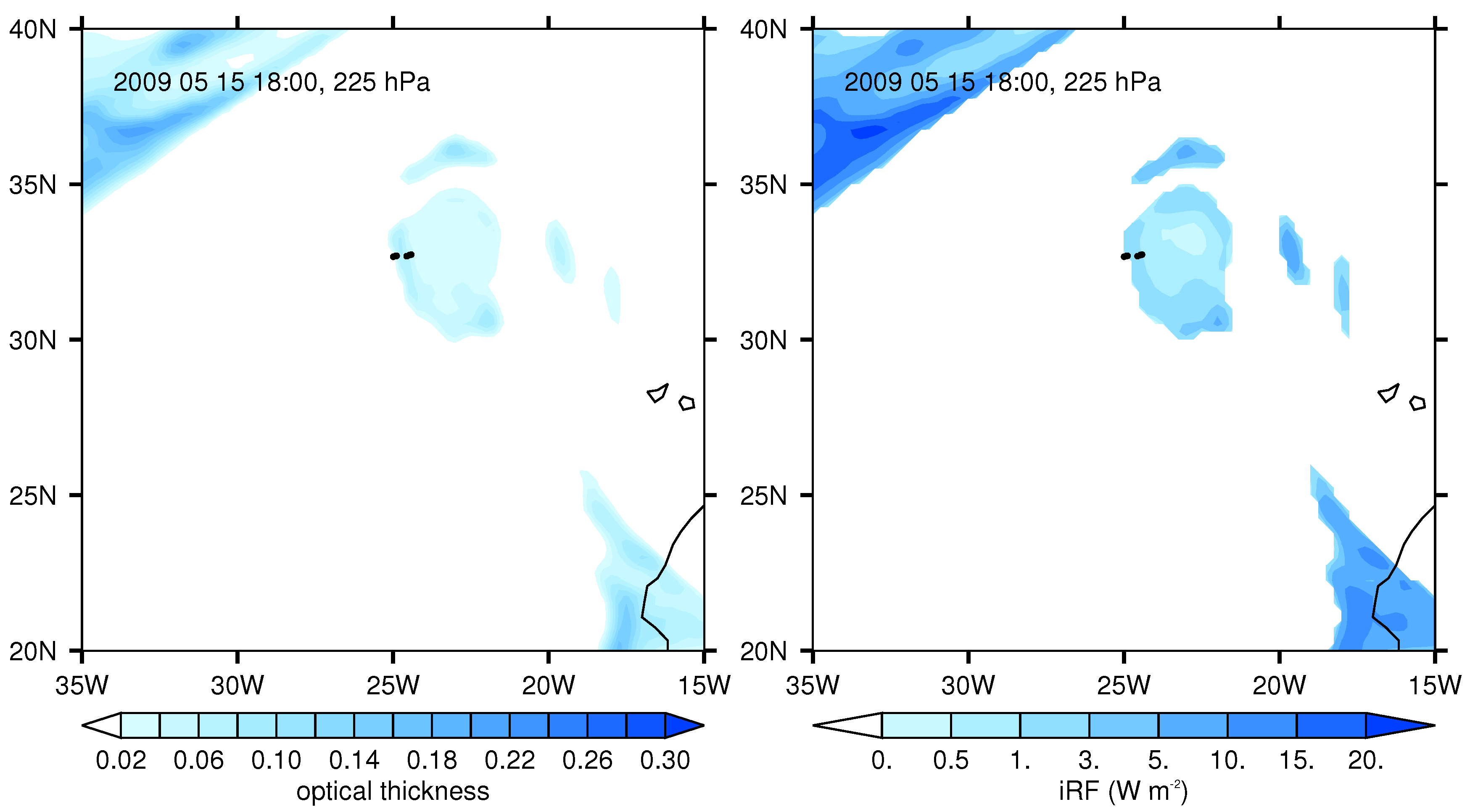
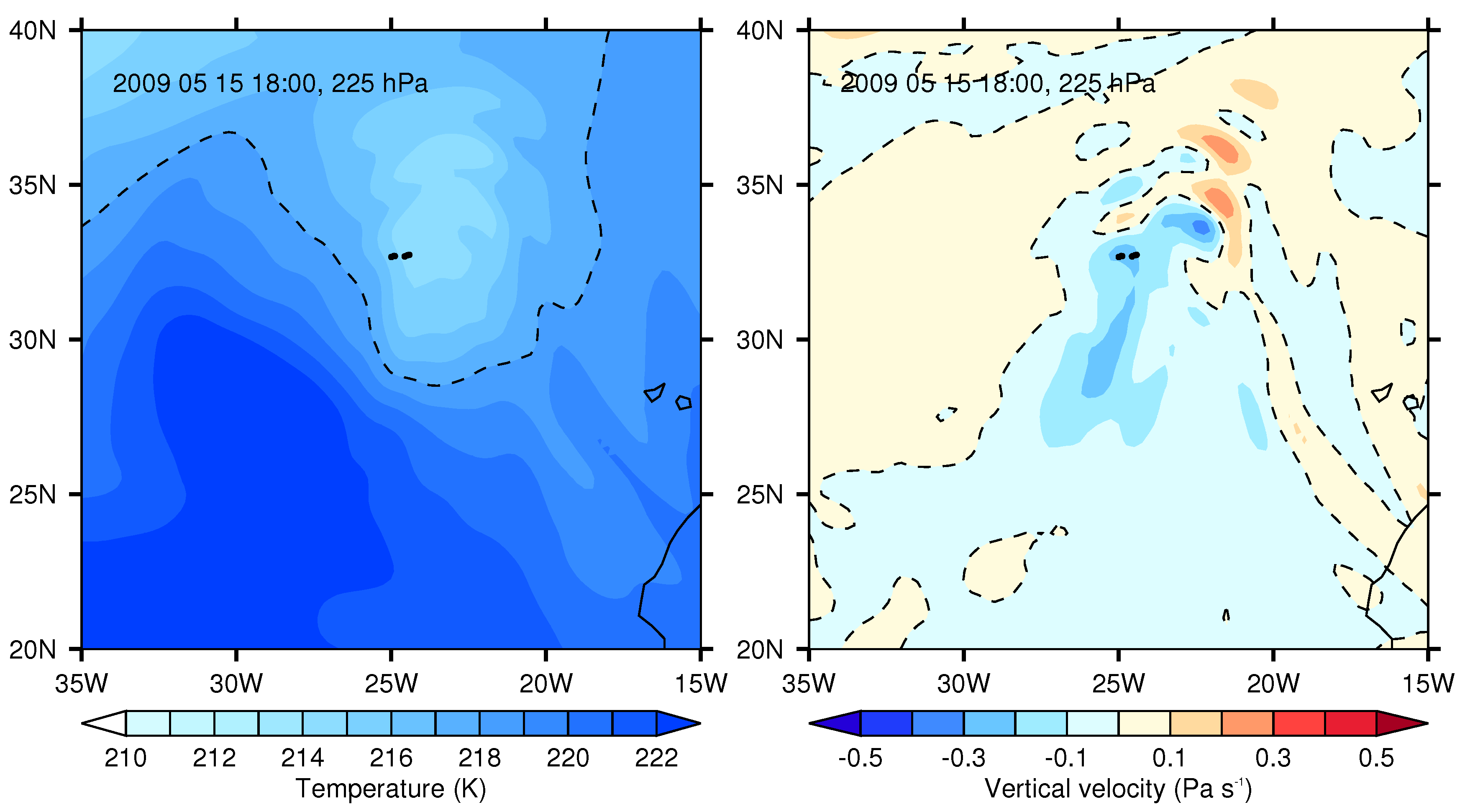
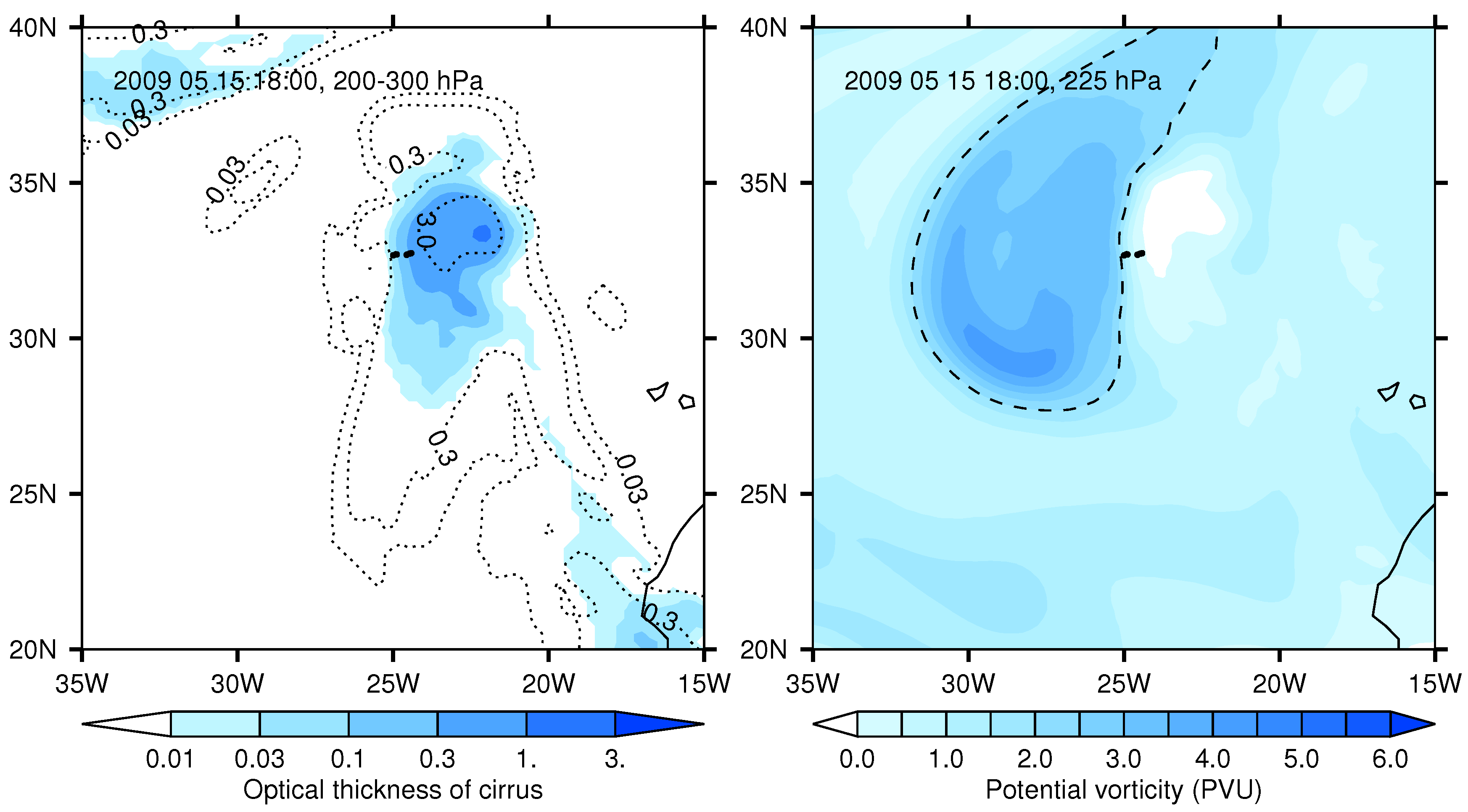

| Month | N | Y/Y | Y/N | N/Y | N/N | ETS |
|---|---|---|---|---|---|---|
| SAC | ||||||
| 01 | 4706 | 3599 | 32 | 117 | 958 | |
| 04 | 2224 | 1726 | 8 | 103 | 387 | |
| 07 | 2552 | 679 | 13 | 319 | 1541 | |
| 10 | 1092 | 838 | 8 | 28 | 218 | |
| Ice-Supersaturation | ||||||
| 01 | 4706 | 34 | 157 | 199 | 4316 | |
| 04 | 2224 | 32 | 91 | 103 | 1998 | |
| 07 | 2552 | 9 | 35 | 102 | 2406 | |
| 10 | 1092 | 8 | 38 | 45 | 1001 | |
Publisher’s Note: MDPI stays neutral with regard to jurisdictional claims in published maps and institutional affiliations. |
© 2020 by the authors. Licensee MDPI, Basel, Switzerland. This article is an open access article distributed under the terms and conditions of the Creative Commons Attribution (CC BY) license (http://creativecommons.org/licenses/by/4.0/).
Share and Cite
Gierens, K.; Matthes, S.; Rohs, S. How Well Can Persistent Contrails Be Predicted? Aerospace 2020, 7, 169. https://doi.org/10.3390/aerospace7120169
Gierens K, Matthes S, Rohs S. How Well Can Persistent Contrails Be Predicted? Aerospace. 2020; 7(12):169. https://doi.org/10.3390/aerospace7120169
Chicago/Turabian StyleGierens, Klaus, Sigrun Matthes, and Susanne Rohs. 2020. "How Well Can Persistent Contrails Be Predicted?" Aerospace 7, no. 12: 169. https://doi.org/10.3390/aerospace7120169





